
Catalog excerpts

Glider user's manual | LEAF2Light User’s manual SUPAIR 34 rue Adrastée Parc Altaïs 74650 Annecy - Chavanod FRANCE 45°54.024’N / 06°04.725’E SUPAIR | LEAF2Light |
Open the catalog to page 1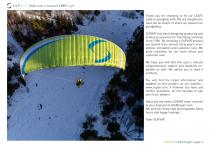
Glider user's manual | LEAF2Light Thank you for choosing to fly our LEAF2 Light to paraglide with. We are delighted to have you on-board to share our passion for paragliding. SUPAIR has been designing producing and selling accessories for free flying activities since 1984. By choosing a SUPAIR product you benefit from almost thirty years of expertise, innovation and customer care. We pride ourselves for our work ethics and customer care. We hope you will find this user's manual comprehensive, explicit and hopefully enjoyable as well. We advise you to read it carefully. You will find the...
Open the catalog to page 2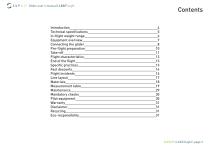
Glider user's manual | LEAF2Light Introduction Technical specifications In-flight weight range Equipment overview Connecting the glider Pre-flight preparation Take-off Flight characteristics End of the flight Specific practices Fast descents Flight incidents Line layout Materials Measurement table Maintenance Mandatory checks Pilot equipment Warranty Disclaimer Recycling Eco-responsibility
Open the catalog to page 3
Glider user's manual | LEAF2Light The wing LEAF2 Light meets all intermediate pilots requirements. It is targeting leisure and XC ( Cross-country ) flying. It will provide, excellent inboard comfort all throughout the pilot progression. The well though out design and choice of materials were guided by the same quality and longevity objectives. The LEAF2 Light glider is EN EN 926 -1 : 2006 & 926 - 2 : 2013 Classe B. Certified. Meaning that this paragliding wing has an excellent level of passive safety margin built-in, in addition to being well beheaved and collapse resistant in turbulent...
Open the catalog to page 4
Glider user's manual | LEAF2Light Glider LEAF2 Light Cell number Flat surface area (m²) Span (m) Chord (m) Flat Aspect Ratio Projected surface area (m²) Projected span (m) Projected aspect ratio Glider weight (kg) In-flight weight range (kg) Certification Acrobatic flying Riser number Speed system Trimmer Other variable device Break travel at maximal weight (cm) Harness dimensions used for certification Technical data yes, tralel: 140mm Oui, travel: 150mm Oui, travel: 150mm Oui, travel: 160mm No No 63 * Length between main suspension points: 40 ±2 cm * Height of main suspension points: 40...
Open the catalog to page 5
Glider user's manual | LEAF2Light In-flight weight range 75 LEAF2 Light XS LEAF2 Light S LEAF2 Light M LEAF2 Light ML In-flight weight range (kg) Perfect In-flight weight range (kg) to optimize flight performances Earth SUPAIR | LEAF2Light | page 6
Open the catalog to page 6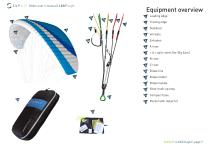
Glider user's manual | LEAF2Light Equipment overview Brake line Brake holder Brake handle Riser hook-up loop Compact Case « A » split risers (for Big Ears) Trailing edge Leading edge Pocket with repair kit
Open the catalog to page 7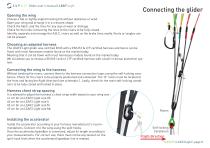
Glider user's manual | LEAF2Light Choose a flat or lightly angled training hill without obstacles or wind. Open your wing and arrange it in a crescent shape. Check the fabric and the lines for any sign of wear or damage. Check for the links connecting the lines to the risers to be fully closed. Identify, separate and arrange the A,B.C, risers as well as the brake lines neatly. Knots or tangles can not be present. Choosing an adapted harness The LEAF2 Light glider was certified EN B with a EN1651 & LTF certified harness and hence can be flown with most harnesses models found on the market...
Open the catalog to page 8
Glider user's manual | LEAF2Light Brake line length fisherman's knot Brake line lengths are set at the factory to allow optimal glider control. However, if they do not suit you they can be adjusted to your liking. We will advise using a fisherman's knot and to keep your length changes to a minimum (approx 5cm maximum). If you modify the original default setting, have it inspected and approved by a professional before flying.. Be certain to adjust and leave a small amount of line slack to keep steering toggle play, prevent wing profile deformation and hinder the accelerator functionality....
Open the catalog to page 9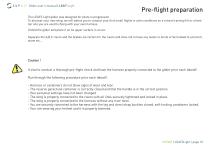
Glider user's manual | LEAF2Light Pre-flight preparation The LEAF2 Light glider was designed for pilots in progression. To discover your new wing, we will advise you to conduct your first small flights in calm conditions on a school training hill or a familiar site you are used to flying with your own harness. Unfold the glider and place it on its upper surface in an arc. Separate the A,B,C risers and the brakes, be certain for the risers and lines not to have any twists or knots or be hooked to a branch, stone etc... Caution ! It vital to conduct a thorough pre-flight check and have the...
Open the catalog to page 10
Glider user's manual | LEAF2Light The design team has strived to produce the LEAF2 Light wing with optimum inflating abilities in all flyable conditions. Whether it be in light or high winds you will enjoy its docile behavior while launching. However before the first flight, practice ground-handling to become familiar with your new glider. It is possible to inflate in a front- or reversed-launch method. Forward launch To inflate the glider grab the upper ends of the "A" risers with your hands and progressively move foreward guiding the glider upward. Once the wing is flying overhead, apply...
Open the catalog to page 11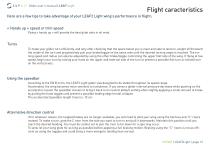
Glider user's manual | LEAF2Light Flight caracteristics Here are a few tips to take advantage of your LEAF2 Light wing's performance in flight: « Hands up » speed or trim speed Flying « hands up » will provide the best glide ratio in nil wind. Turns To make your glider turn efficiently, and only after checking that the space below you is clear and safe to land on, weight shift toward the inside of the turn and progressively pull your brake/toggle on the same side until the desired turning angle is reached. The turning speed and radius can also be adjusted by using the other brake/toggle...
Open the catalog to page 12
Glider user's manual | LEAF2Light Landing Be certain to always have enough altitude for a safe landing before approaching the chosen Landing Zone ( PTU, PTS, etc...). Never make aggressive maneuvers close to the ground. Always land into the wind ( upwind ), standing up and ready to run to a stop if necessary. Make your landing approach with maximum air speed if possible depending on the weather conditions of the moment, then progressively brake to slow the glider to a final touchdown. Beware not to brake too much, too soon and too rapidly to prevent a possible stall and hard landing. In...
Open the catalog to page 13All SupAir-VLD catalogs and technical brochures
-
RADICAL 3
30 Pages
-
VIP LITE
14 Pages
-
EVEREST3
18 Pages
-
MINIMAX BUMP
17 Pages
-
EVO LITE
39 Pages
-
DELIGHT 3
31 Pages
-
SKYPPER 2
37 Pages
-
ACRO 4
34 Pages
-
ALTIRANDO LITE
33 Pages
-
PIXAIR 2
35 Pages
-
ACCESS 2 BUMP
38 Pages
-
ACCESS 2 AIRBAG
37 Pages
-
MINIMAX 3
22 Pages
-
WALIBI 3
38 Pages
-
STRIKE 2
40 Pages
-
KINDER 2
20 Pages
-
LOUSTIC 2
20 Pages
-
FLUID
30 Pages
-
START
15 Pages
-
SHINE
22 Pages
-
STEP
36 Pages
-
LEAF 2
36 Pages
-
SAVAGE
30 Pages
-
STEP light
29 Pages
-
SORA 2 PLUS
28 Pages
-
EONA 3
36 Pages
-
CATALOGUE SUPAIR 2017 2018
39 Pages





























